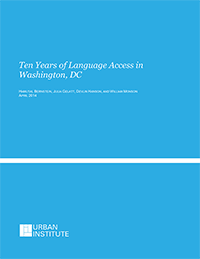 To commemorate the 10 year annivesary of the DC Language Access Act, our office commissioned a report from the Urban Institute to reflect on 10 years of implementation and make recommendations on how to further improve government services for those who are limited and non-English proficient (LEP/NEP). The report, released in April 2014, along with input from government agencies and community advocates will help guide the Language Access Program as it continues to strive to provide equal services to LEP/LEP people.
To commemorate the 10 year annivesary of the DC Language Access Act, our office commissioned a report from the Urban Institute to reflect on 10 years of implementation and make recommendations on how to further improve government services for those who are limited and non-English proficient (LEP/NEP). The report, released in April 2014, along with input from government agencies and community advocates will help guide the Language Access Program as it continues to strive to provide equal services to LEP/LEP people.
10 Years of Language Access in Washington, DC: Executive Summary
Ten years ago, the District of Columbia enacted the DC Language Access Act of 2004, which requires all District agencies, and especially those with significant public contact, to ensure that limited English proficient (LEP) and non–English proficient (NEP) residents have full access to services. Because LEP/ NEP residents often face barriers in their interactions with public agencies, the District passed language access legislation to require local agencies to provide translation and interpretation resources to all LEP/NEP clients. DC is one of only a few cities in the United States to have passed such legislation.
The imperative for language access stems from the District’s rich diversity. The metropolitan region has become an important immigration hub over the past several decades, with significant growth and diversification of residents in the inner and outlying suburbs of Virginia and Maryland, as well as in the District. The District’s foreign-born population accounts for more than a third of its population growth since 2007. Similar to trends throughout the region, the District has an extremely diverse immigrant population; no one country of birth makes up more than 16 percent of the foreign-born. In this context, ensuring access for LEP/NEP residents is critical. In the greater DC area,1 1 in 10 individuals over the age of 5 is LEP/NEP; in the District, the share is about 1 in 20. More than 85 percent of LEP/NEP people living in the District are foreign-born, but a substantial proportion (15 percent) are US-born. Given both the large number and the diversity of LEP individuals in DC, challenges arise when attempting to provide services to this community. The District’s Language Access Program has strived over the past 10 years to support these language needs.
This report offers an overview of the Language Access Program and Washington’s LEP/NEP population. We first present the context of the District as a city that draws immigrants from around the world. We then describe DC’s Language Access Program, its creation, and evolution, and profile the city’s LEP/NEP population. Next, we identify accomplishments and challenges for each of the three major domains required for ensuring full language access: identifying language needs, serving language needs, and monitoring the provision of those services. We conclude with recommendations for next steps for city government officials and other stakeholders as they continue to strengthen the Language Access Program in the District.
The demographic profile is based on the American Community Survey (ACS), which is the best available data source providing detailed demographic and household characteristics on a large, representative sample of US households. The program overview is based on existing literature, DC government documents and reports, and perspectives from a small group of stakeholders. Specifically, we reviewed the literature on best practices for language access policy and on immigration and language access in DC. In addition, we conducted 11 interviews with 14 stakeholders from city government and immigrant-serving nonprofits in DC, who have worked directly on language access issues at different stages of the implementation of the program. Although the research team drew on multiple sources as described, interview participants were recruited by the Office of Human Rights and the mayor’s constituent offices. It is important to note this limitation to the study, as it introduced a potential source of bias.
The findings describe a pioneering Language Access Act that emerged through a community-based effort led by the DC Language Access Coalition, made up of diverse immigrant-serving organizations that recognized the importance of ensuring full access to DC’s LEP/NEP residents. Coordinated and monitored by the Office of Human Rights, the Language Access Program is supported by the active engagement of partners and implemented directly by frontline and Language Access team staff at a wide range of District agencies. The structure and specific activities of the Language Access Program have evolved and modernized over the past decade, with significant accomplishments in increasing public and agency awareness, as well as expanding available translation and interpretation resources. The complexity of assessing the language needs of an extremely diverse LEP/NEP population, across a wide array of agencies and with limited resources, poses a key challenge to the success of the program. Recommendations focus on continuing to improve data collection and analysis, recognizing the importance of human capital and bilingual skills, improving service quality and accessibility, improving coordination between agencies, pursuing aggressive community engagement, continuing the transparent monitoring system, examining enforcement possibilities, and considering further investments in a program that still faces considerable hurdles despite significant strides over the past decade.


